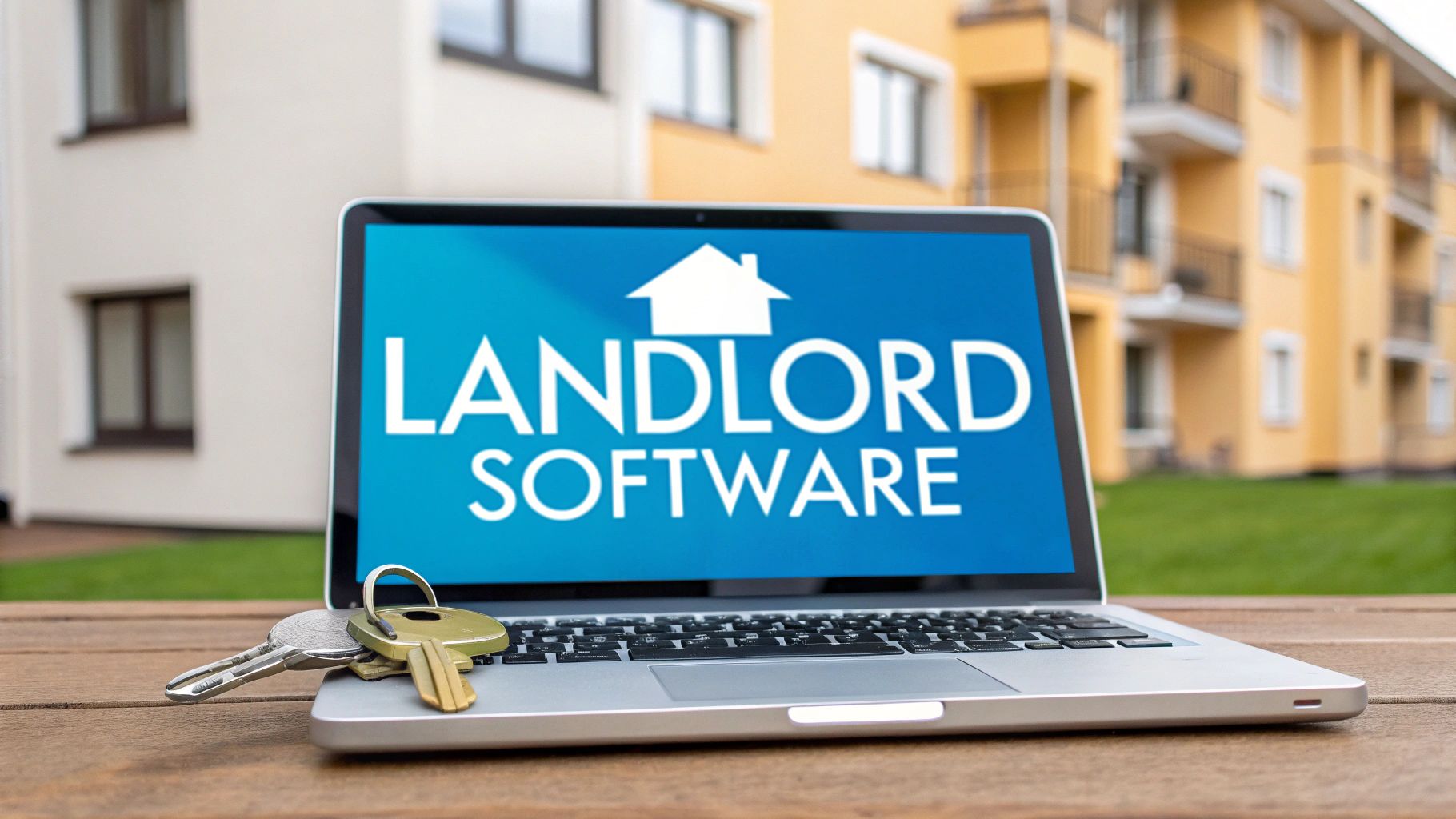For property management companies managing portfolios of 100 to 10,000+ units, operational efficiency isn't just a goal; it's the core of profitability. Spreadsheets and disjointed systems quickly become liabilities, creating data silos that slow down leasing and inflate operational costs. Every vacant day directly impacts revenue, making speed-to-lease and lead-to-tour conversion the most critical metrics for scalable growth. The right technology is the difference between expanding your portfolio and getting buried in administrative chaos. This guide is built for enterprise-level operators, cutting through the marketing noise to deliver an in-depth analysis of the best rental property management software available today.
We focus on the features that truly matter for managing distributed portfolios: robust automation, seamless API integration capabilities, and the power to demonstrably slash Days on Market (DOM). Each platform reviewed is evaluated on its ability to support remote management, optimize cost-per-door, and deliver a measurable return on investment. According to a 2024 analysis, 70% of property managers cite operational efficiency as their top priority, a challenge that can only be met with a sophisticated tech stack. While sophisticated software automates complex workflows, mastering foundational tasks is still essential for quality control at scale. For instance, using a comprehensive rental property inspection checklist ensures property standards are met consistently across every unit, a process many platforms now help digitize.
This resource provides a side-by-side comparison of the leading solutions, complete with screenshots, direct links, and honest assessments of their pros and cons. You will gain a clear understanding of which system is best equipped to serve as your operational backbone, enabling you to standardize processes, improve key performance indicators, and drive portfolio performance.
1. Showdigs
Showdigs stands out as the best rental property management software for leasing automation, specifically engineered for single-family and distributed portfolios of 100+ units. It addresses a critical operational bottleneck for large portfolios: the entire leasing funnel, from initial lead to lease signing. By merging an AI-backed software platform with a nationwide network of on-demand, licensed agents, Showdigs provides a comprehensive solution that significantly reduces days on market (DOM) and streamlines leasing operations for property managers handling geographically dispersed properties. This focus on speed is critical; for a 1,000-unit portfolio with an average rent of $2,000, reducing DOM by just one day can recover over $65,000 in annual revenue.
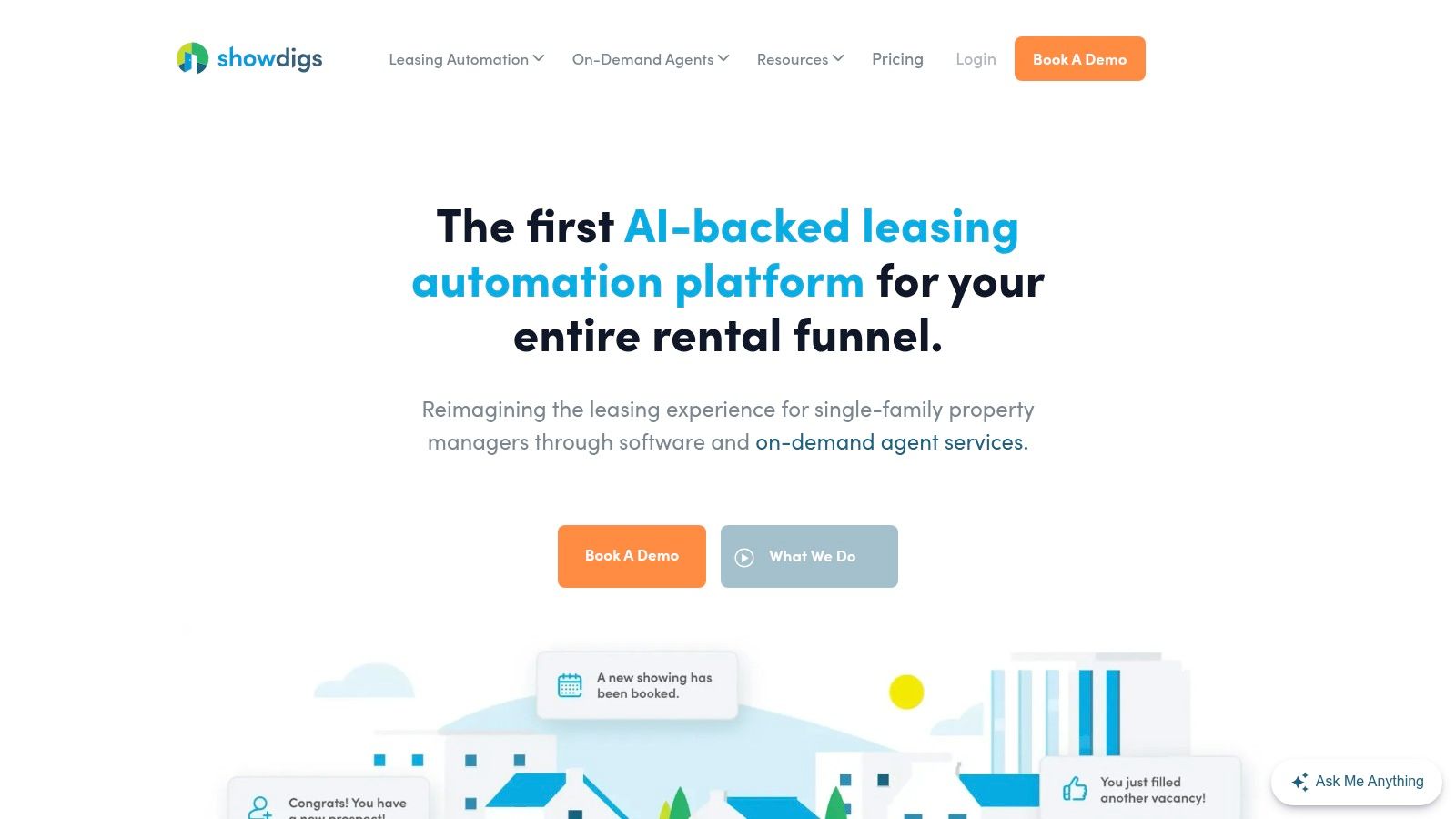
The platform’s core strength lies in its hybrid model. It automates lead triage, pre-screening, and scheduling while offering both self-showing technology and access to a human agent network for in-person tours. This flexibility is paramount for remote management, allowing companies to standardize showing operations across diverse markets without onsite staff. Deep API integrations with major property management systems like AppFolio and Yardi/Rentvine ensure seamless data synchronization, eliminating redundant data entry and keeping workflows cohesive.
Key Strengths & Use Cases
DOM Reduction at Scale: Showdigs automates the entire leasing process. A practical use case involves a portfolio manager listing a new vacancy; the system automatically syndicates the listing, fields inquiries 24/7, pre-screens prospects against custom criteria, and allows qualified leads to schedule a showing instantly without human intervention. This accelerates the lead-to-tour conversion rate, with some clients reporting a 40% reduction in DOM.
Hybrid Showing Model for Remote Operations: The platform uniquely combines nationwide self-showing lockboxes with an on-demand network of licensed real estate agents. This is ideal for multi-market portfolios. For instance, a firm in California can use local Showdigs agents for agent-led tours and condition reports while managing properties in a different state using the platform's self-showing technology, standardizing quality control without hiring W-2 staff.
Enterprise Integration & Customization: Unlike rigid, one-size-fits-all solutions, Showdigs allows for extensive workflow customization. Teams can use smart tags, custom fields, and automated notifications to mirror their existing processes. Its robust API and native integrations mean it functions as a powerful leasing front-end that complements your core property management software, ensuring a seamless tech stack.
“What used to take us 30 minutes to do is now a five-minute task. It doesn’t sound like much, but when you do it ten times a day, every day… that time really adds up.” - Kathryn Shabalov, Managing Broker, Gotcha Covered Property Management
Limitations and Pricing
Showdigs’ primary limitations are its target market and pricing model. The platform is purpose-built for property managers with at least 100 units, making it less suitable for small landlords. Furthermore, pricing is not publicly available and requires a consultation, as it is tailored to portfolio size and needs. Access to the on-demand agent network also requires a software subscription, though some services like photos and condition reports can be ordered a la carte.
As you evaluate different solutions, you can learn more about how Showdigs stacks up to other platforms to make an informed decision.
Website: https://showdigs.com
2. AppFolio Property Manager
AppFolio Property Manager is a comprehensive, cloud-based platform designed for property management companies overseeing mid-to-large-scale portfolios, including residential, commercial, student housing, and community associations. It centralizes core property management operations, moving beyond basic accounting and tenant tracking to offer an end-to-end solution that addresses the full leasing lifecycle. The platform is engineered to drive operational efficiency, reduce days on market (DOM), and provide a seamless digital experience for both tenants and owners.
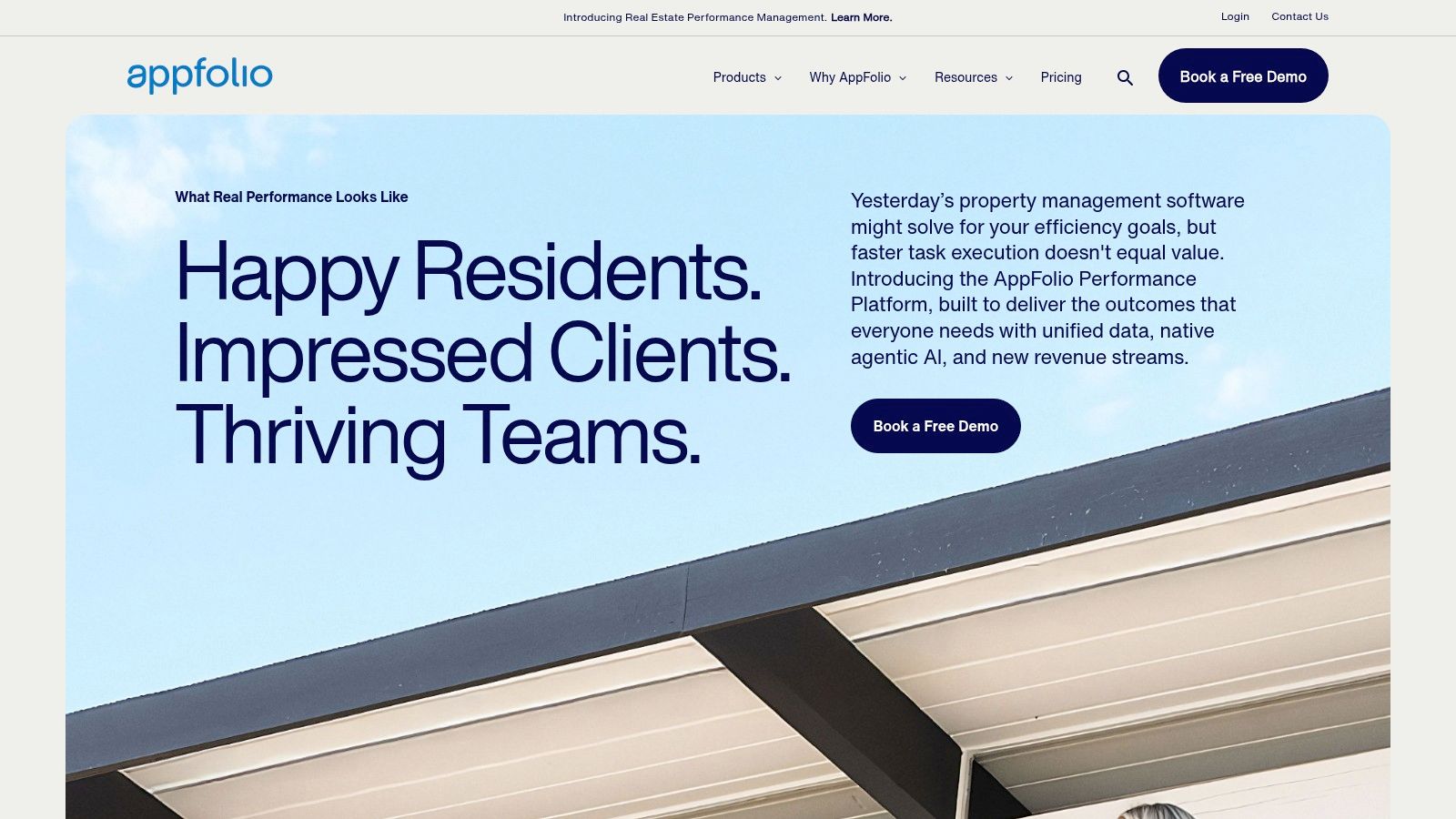
What sets AppFolio apart is its deep integration of automation and AI. Its AI Leasing Assistant, Realm, can handle lead inquiries, schedule showings, and answer common questions 24/7, which is critical for maximizing lead-to-tour conversion rates. This focus on automation allows property managers to systematize processes across large, distributed portfolios.
Key Features & Considerations
AppFolio’s functionality is robust, covering everything from online rent payments and maintenance requests to sophisticated accounting and performance reporting. The platform’s integration ecosystem, AppFolio Stack, allows for certified third-party tools to connect directly, enhancing capabilities without clunky workarounds. For instance, you can learn more about the AppFolio and Showdigs integration to see how it streamlines on-demand tour scheduling and accelerates speed-to-lease.
- Best For: Mid-size to enterprise-level property management firms (50+ units) needing a scalable, all-in-one system.
- Pricing: Quote-based with per-unit fees and a monthly minimum. Onboarding fees apply, and premium features or integrations come at an additional cost.
- Pros: Highly scalable architecture, powerful workflow automation, and an extensive, well-integrated feature set.
- Cons: The 50-unit minimum and quote-based pricing make it inaccessible for smaller landlords. The total cost of ownership can be high once add-ons are included.
Visit AppFolio Property Manager Website
3. Buildium
Buildium is a well-established, cloud-based platform designed to serve the needs of small to mid-sized residential property managers and associations. As a RealPage company, it offers a mature and comprehensive suite of tools that address the core operational requirements of managing rental portfolios. The platform focuses on streamlining day-to-day tasks, from accounting and maintenance coordination to tenant communication and leasing, making it a strong contender for professionals seeking an all-in-one system with transparent pricing.
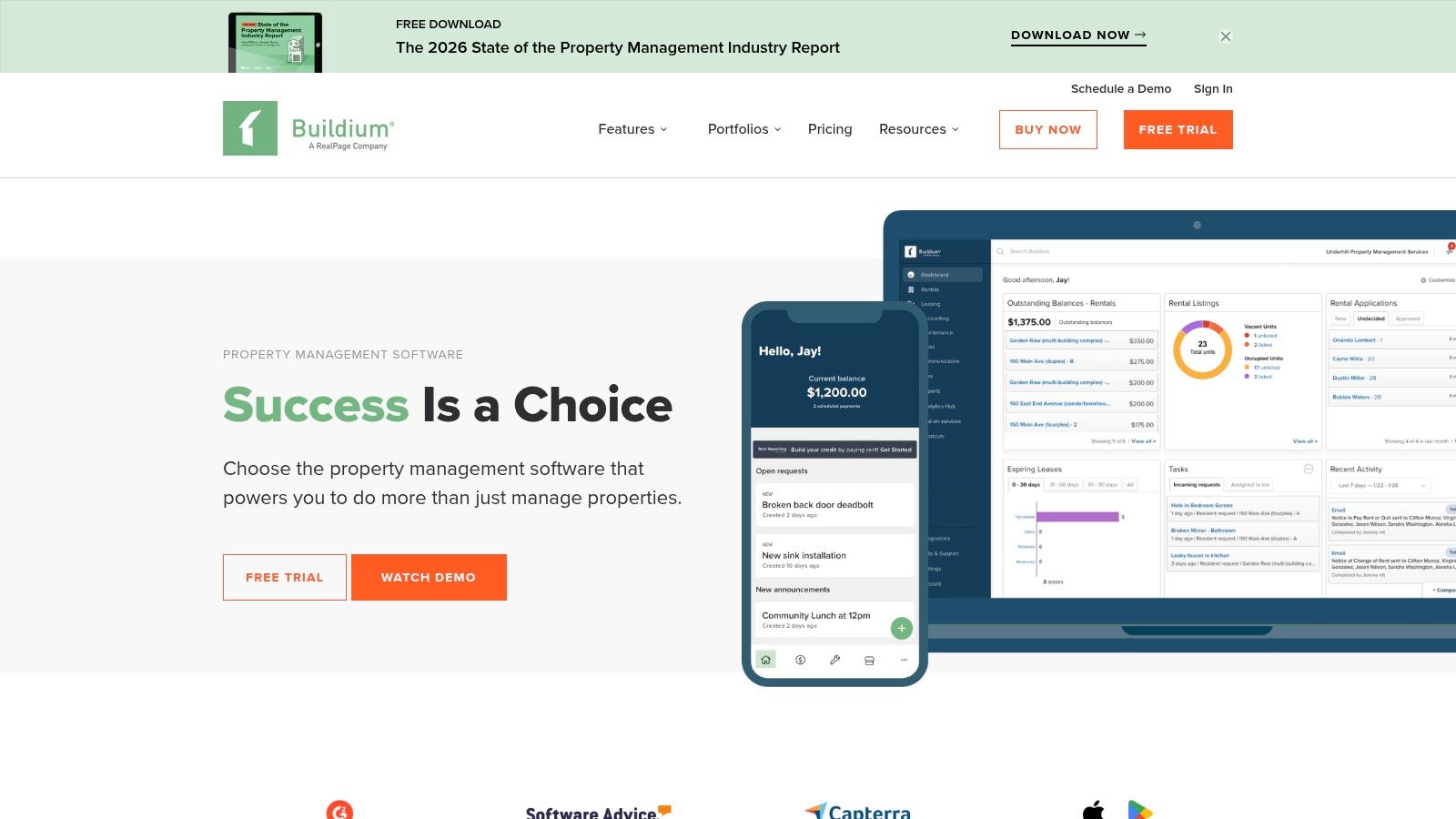
What sets Buildium apart is its accessibility and clear, tiered structure. Unlike enterprise-level systems that often require custom quotes, Buildium provides a straightforward path for growing property management businesses to adopt sophisticated software. This approach, combined with a 14-day free trial, allows managers to evaluate its functionality firsthand, ensuring it aligns with their operational workflow and portfolio size before committing. This makes it one of the more approachable choices when evaluating the best rental property management software for growth-oriented portfolios.
Key Features & Considerations
Buildium's core functionality is built around essential property management modules, including robust accounting, maintenance request tracking, tenant and owner portals, and violation management. Its feature set also extends to integrated services like tenant screening, eSignatures, and property inspections. The platform's three distinct pricing tiers (Essential, Growth, and Premium) allow managers to select a plan that matches their current needs and scale up as their portfolio expands, adding more advanced features and integrations along the way.
- Best For: Small to mid-sized property management companies and associations looking for a scalable, full-featured platform with clear pricing.
- Pricing: Tiered monthly subscription model (Essential, Growth, Premium) based on the number of units managed. A free 14-day trial is available.
- Pros: Transparent pricing tiers make it easy to budget, and the free trial lowers the barrier to entry. Higher tiers include valuable live phone support.
- Cons: Transaction fees for services like incoming EFT payments can apply on lower-tier plans. Onboarding for Growth and Premium tiers is required and adds to the initial cost and setup time.
4. Yardi Breeze / Breeze Premier
Yardi Breeze is the streamlined, cloud-based property management software solution from Yardi, a longstanding leader in the real estate technology space. It is specifically designed to be an accessible, all-in-one platform for residential and commercial property managers who need robust functionality without the complexity of enterprise-level systems. The platform offers a simplified user experience that centralizes marketing, leasing, accounting, maintenance, and owner reporting into a single, intuitive interface.

What distinguishes Yardi Breeze is its two-tiered offering: Breeze and Breeze Premier. This structure allows property management companies to start with a foundational toolset and scale up to Premier for more advanced features like job costing, corporate accounting, and enhanced reporting as their portfolio grows. This scalability, combined with transparent pricing, makes it one of the best rental property management software options for businesses planning for future expansion.
Key Features & Considerations
Yardi Breeze covers the complete property management lifecycle, from listing vacancies on a custom professional website to processing online payments and managing maintenance requests. Its clear, per-unit pricing model is a significant advantage for budgeting and forecasting operational costs. The Premier version adds sophisticated tools that cater to more complex portfolio needs, bridging the gap between basic software and Yardi's enterprise-level Voyager platform.
- Best For: Small to mid-sized property management companies seeking a scalable, user-friendly platform with transparent pricing and the backing of a major industry player.
- Pricing: Published per-unit, per-month pricing with stated monthly minimums. Breeze starts at $1 per unit, and Breeze Premier starts at $2 per unit, with variations by property type.
- Pros: Transparent and predictable pricing structure, scalable two-tiered system (Breeze and Breeze Premier), and comprehensive features covering multiple asset types.
- Cons: The monthly minimums may still be a hurdle for landlords with very few properties, and some advanced features are locked behind the more expensive Premier plan.
5. Rent Manager
Rent Manager is a highly configurable property management platform known for its flexibility and power, serving sophisticated operators who require deep customization. Unlike many one-size-fits-all solutions, it is available as a cloud-based service or an on-premises installation, giving companies control over their data and infrastructure. The software is designed to handle complex accounting, extensive reporting, and intricate operational workflows for diverse portfolios, including residential, commercial, and mixed-use properties.
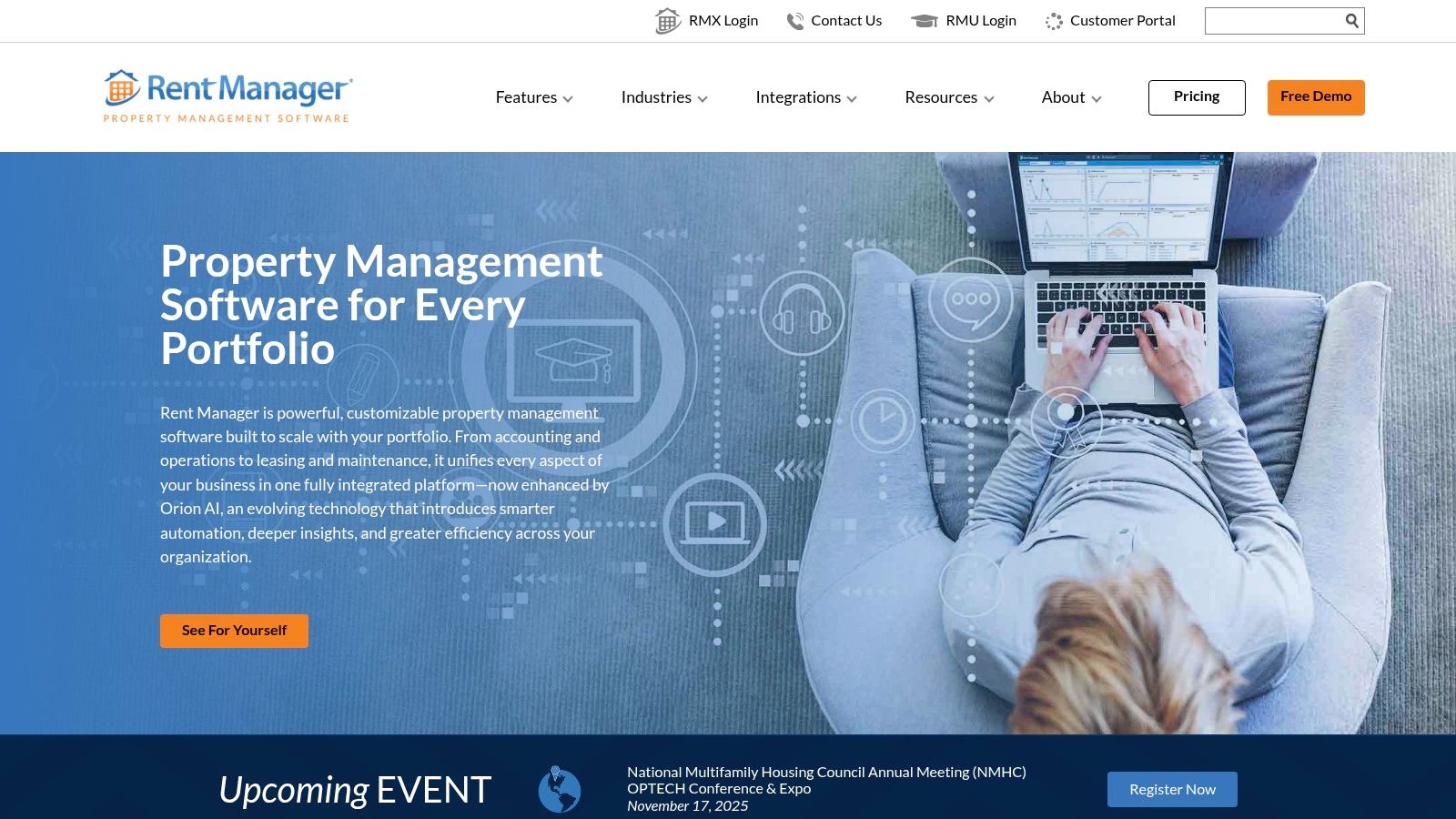
What truly distinguishes Rent Manager is its open API and unparalleled level of customization. This allows property management companies to build bespoke workflows and integrate specialized third-party tools, creating a tech stack tailored to their specific operational needs. It's a platform built for property managers who want to dictate how their software works, not the other way around. This makes it a top choice for firms with unique business processes that standard software cannot accommodate.
Key Features & Considerations
Rent Manager’s features are bundled into Basic, Plus, and Premium tiers, allowing some scalability. Its reporting engine is a major draw, with over 450 built-in reports that provide deep financial and operational insights. The platform also offers modern tools like unlimited e-signatures and AI-assisted accounts receivable/payable and writing tools. Add-on services, including a call center, website development, and integrated phone systems, allow companies to create a centralized operational hub.
- Best For: Large-scale property management firms with complex or unique operational workflows that require deep customization and robust reporting.
- Pricing: Quote-based, with pricing complexity that reflects its high degree of customization. Implementation packages are required and typically cost around twice the monthly fee.
- Pros: Extremely powerful customization and reporting capabilities, a strong open API and integration ecosystem, and dedicated implementation resources.
- Cons: The quote-based pricing can be complex and less transparent. Significant upfront implementation costs make it a substantial initial investment.
6. Propertyware
Propertyware is a powerful, cloud-based platform from RealPage, specifically engineered for single-family residential (SFR) property management companies. Its architecture is purpose-built to handle the unique challenges of managing large, geographically dispersed SFR portfolios. The software provides a centralized hub for accounting, maintenance, marketing, and communication, enabling property managers to standardize operations and scale effectively across different markets. It is designed to be a comprehensive solution for managers who need robust customization and deep financial reporting.

What makes Propertyware a top contender in the best rental property management software category is its focus on customizable workflows and in-depth analytics. Unlike more rigid systems, it allows users to tailor fields, reports, and processes to match their specific operational needs. This flexibility is crucial for large-scale operators aiming to implement and enforce consistent procedures across their entire portfolio, ensuring every property is managed to the same high standard.
Key Features & Considerations
Propertyware's functionality is segmented into clear tiers, allowing businesses to choose the level of complexity they require. All plans include core features like owner and tenant portals, online payments, maintenance work order management, and tenant screening. Higher tiers add advanced features such as eSignatures, inspections, and a vendor portal, providing a complete ecosystem for managing the single-family rental lifecycle from a single dashboard.
- Best For: Mid-to-large-scale single-family portfolio managers (50+ units) who require deep customization and robust, property-level accounting.
- Pricing: Tiered per-unit pricing (Basic, Plus, Premium) with monthly minimums ranging from $250 to $450. A one-time implementation fee, typically equal to two times the monthly subscription, is also required.
- Pros: Highly customizable platform built specifically for the SFR niche, clear per-unit pricing tiers, and claims of unlimited customer support and training.
- Cons: The high monthly minimums and significant implementation fee make it cost-prohibitive for smaller landlords or those just starting to scale.
7. DoorLoop
DoorLoop positions itself as an all-in-one property management software designed for rapid implementation and ease of use. It serves a broad market, including residential, commercial, student housing, and community associations, with a focus on streamlining core tasks like marketing, leasing, and payment collection. The platform is engineered to be intuitive, allowing managers to get up and running quickly without a steep learning curve, making it a strong contender in the best rental property management software category.

What makes DoorLoop stand out is its commitment to transparency, particularly with its pricing and ancillary fees. Unlike platforms with opaque, quote-based models, DoorLoop publishes its subscription plans and the associated costs for services like ACH payments and tenant screening. This straightforward approach allows property managers to forecast their total cost of ownership more accurately and build a scalable tech stack without unexpected expenses.
Key Features & Considerations
DoorLoop's feature set is tiered across three main plans, allowing users to select the level of functionality that matches their portfolio size and complexity. Core offerings include a tenant portal, online rent payments, maintenance management, and a full accounting suite with bank reconciliation. Higher-tier plans add features like a customizable website, e-signatures, and advanced user permissions, providing a clear growth path within the platform. The software's interface is clean and modern, prioritizing user experience to reduce onboarding friction for new team members.
- Best For: Small to mid-sized property managers and landlords who prioritize a user-friendly interface and transparent, predictable pricing.
- Pricing: Starts at $49/month for up to 20 units (billed annually). Three-tiered plans (Starter, Pro, Premium) with published per-unit fees.
- Pros: Transparent pricing with clearly stated ancillary fees for payments and screening. The platform is known for its simple onboarding process and intuitive design.
- Cons: Advanced features are locked behind higher-priced tiers. Subscription costs can vary depending on promotional offers, and some fees can be passed on to either landlords or tenants.
8. TenantCloud
TenantCloud is a cloud-based platform specifically designed to serve the needs of DIY landlords and growing property managers. It offers a low-cost entry point into the world of rental property management software, providing core workflows for listing syndication, tenant screening, online rent collection, and maintenance management. The platform is structured with tiered plans, allowing users to start free and scale up their feature set as their portfolio expands, making it a highly accessible option for those new to property management technology.

What sets TenantCloud apart is its focus on affordability and a feature-rich free tier, which is rare in the market. This approach allows landlords to digitize their operations without a significant upfront investment. As portfolios grow, paid tiers unlock more advanced functionalities like property inspections, QuickBooks Online integration, and sophisticated team management tools, ensuring the platform can support managers as they scale from a few units to a small professional team.
Key Features & Considerations
TenantCloud's core functionality covers the entire rental lifecycle, from marketing vacancies to handling maintenance and accounting. Higher-tier plans add valuable tools such as bank reconciliation and team permission settings, which are critical for growing management companies. Its straightforward interface makes it easy for landlords to manage properties without a steep learning curve, and the option for tenants to pay for ACH transfers can significantly reduce operational costs for owners.
- Best For: DIY landlords, small property managers, and owners with portfolios under 50 units seeking an affordable, scalable solution.
- Pricing: Offers a free basic plan for up to 75 units. Paid plans (Starter, Growth, Pro) are available on a competitive monthly subscription basis, with a 14-day free trial.
- Pros: Highly affordable pricing model with a robust free tier, unlimited maintenance requests on all plans, and tenant-paid ACH options to reduce owner costs.
- Cons: Advanced features like multi-entity banking and robust team management tools are reserved for the most expensive tiers. Some core functionality is limited on the free plan.
9. TurboTenant
TurboTenant is a freemium rental management platform built specifically for independent landlords in the U.S. who manage small-to-medium-sized portfolios. It provides a comprehensive suite of tools to streamline the entire rental lifecycle, from marketing a vacant unit to collecting rent, without the high entry costs or per-unit fees typical of more complex systems. The platform’s core value proposition is its free-to-use base tier, which covers essential functions like property listings, tenant screening, and rent collection.
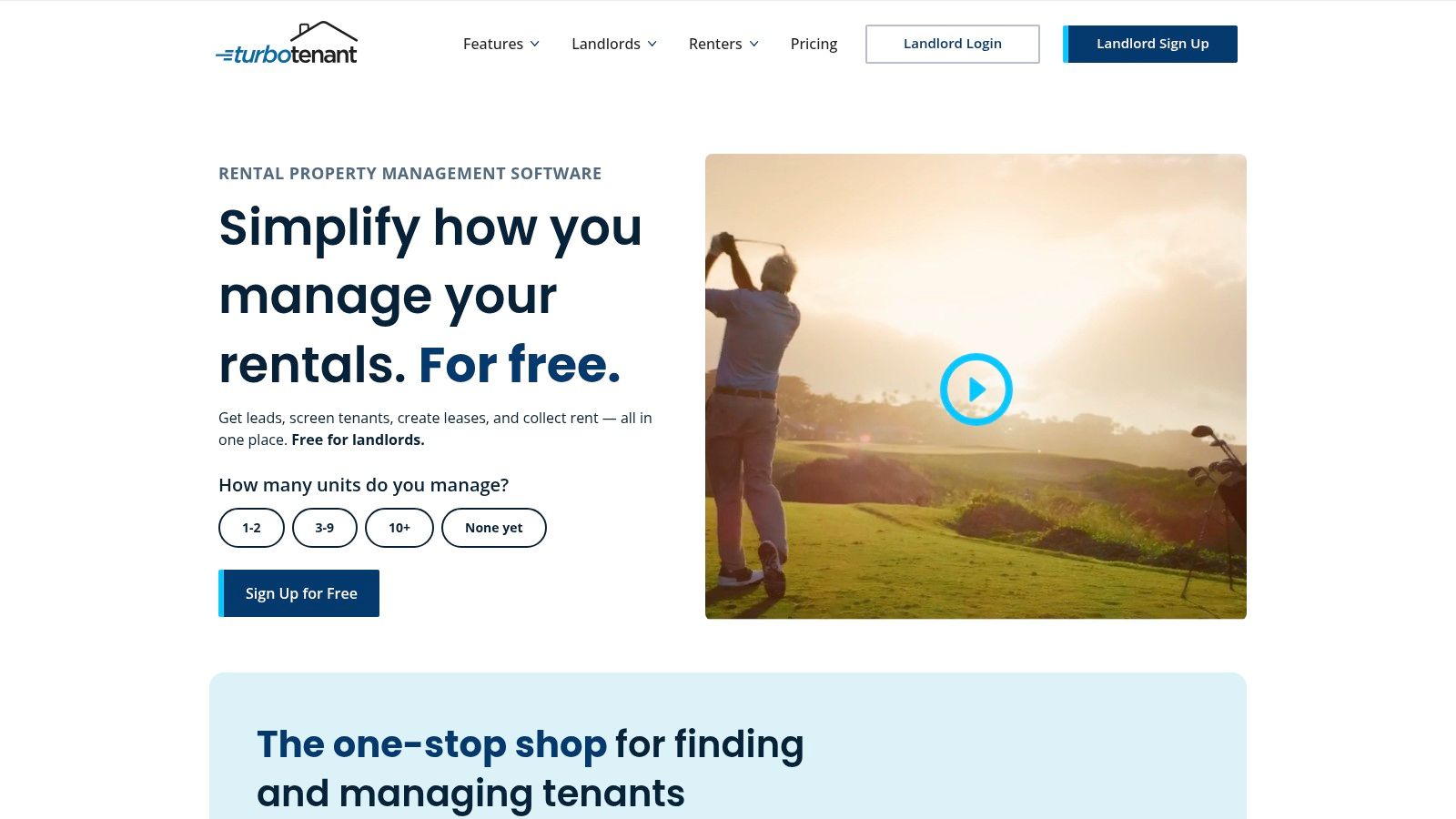
What makes TurboTenant a standout option in the crowded field of the best rental property management software is its accessibility. It democratizes professional-grade tools for landlords who may not have the scale to justify expensive enterprise software. This focus on simplicity and a zero-cost entry point allows property owners to systematize their operations quickly, professionalize their tenant interactions, and reduce administrative overhead without a significant upfront investment.
Key Features & Considerations
TurboTenant’s functionality is centered on the core needs of a landlord. Its free plan supports unlimited properties and includes listing syndication, pre-screening questionnaires, and online applications. While the base product is robust, the platform operates on a model where landlords can opt into premium features or tenants can pay for services like screening reports. This à la carte and tiered approach provides flexibility, allowing users to pay only for the advanced tools they need.
- Best For: Independent landlords and small property managers (1-50 units) seeking a cost-effective, easy-to-use solution for core management tasks.
- Pricing: A free core plan is available. The Premium plan is subscription-based (billed annually) and adds features like unlimited lease agreements, e-signatures, and faster rent payouts.
- Pros: Free plan for unlimited properties makes it highly accessible. The user interface is straightforward and designed for quick setup and ease of use.
- Cons: Advanced features require a paid annual subscription. Some services, like tenant screening reports, incur fees passed on to the applicant or landlord.
10. Avail
Avail, a platform from Realtor.com, is specifically engineered for DIY landlords and smaller property managers who need an accessible yet powerful set of tools. It offers a comprehensive solution that covers the entire rental lifecycle, from listing syndication and tenant screening to creating state-specific leases and collecting rent online. The platform focuses on providing compliance, convenience, and professional-grade resources without the steep learning curve or high costs associated with enterprise-level systems.
What distinguishes Avail is its emphasis on legally sound, localized documentation. Its library of lawyer-reviewed, state-specific lease agreements and templates provides a critical layer of protection for smaller landlords who may not have in-house legal counsel. This focus on compliance, combined with its transparent pricing and robust free tier, makes it one of the best rental property management software options for those just starting to scale their portfolios.
Key Features & Considerations
Avail simplifies core landlord responsibilities through a clean, user-friendly interface. The platform's free plan is remarkably functional, offering syndication, screening, and rent collection, while the paid tier unlocks valuable features like waived ACH fees, custom leases, and expedited rent payments. This structure allows landlords to grow into the platform as their needs evolve.
- Best For: Independent landlords and small property managers (1-20 units) seeking a free or low-cost solution with strong lease compliance features.
- Pricing: Offers a robust free "Unlimited" plan. The "Unlimited Plus" plan is priced at $7 per unit per month.
- Pros: Excellent library of state-specific, legally reviewed lease templates; generous free plan covers all core functions; transparent fee structure for tenants and landlords.
- Cons: The per-unit pricing on the Plus tier can become less cost-effective as a portfolio grows; some advanced accounting and reporting features are limited compared to larger platforms.
11. RentRedi
RentRedi is a mobile-first property management software designed for landlords who prioritize on-the-go accessibility and simplicity. It stands out by offering unlimited units, tenants, and teammates across all its subscription plans, making it a highly scalable and cost-effective solution for landlords with growing portfolios. The platform provides dedicated mobile apps for both landlords and tenants, streamlining communication and core tasks like rent collection and maintenance requests directly from their smartphones.

What makes RentRedi a strong contender in the rental property management software space is its straightforward, all-inclusive pricing model that eliminates per-unit fees. This approach provides predictable costs, which is especially valuable for investors scaling from a few properties to dozens. Its core functionality covers the essentials effectively, including tenant screening, listing syndication to Zillow and its partners, online payments, and maintenance tracking, all managed through an intuitive mobile interface.
Key Features & Considerations
RentRedi’s model is built on providing a robust core platform with the flexibility to add specialized services as needed. While the base subscription is comprehensive, users can opt into premium add-ons like maintenance coordination and full-service accounting to enhance capabilities. This à la carte structure allows landlords to customize their software stack without paying for enterprise-level features they don't yet require, ensuring the system grows with their operational needs.
- Best For: Independent landlords and small-to-midsize property managers seeking a mobile-centric platform with predictable, flat-rate pricing for unlimited units.
- Pricing: Offers monthly, 6-month, and annual plans with flat-rate pricing. Add-on services for accounting and maintenance are available at an extra cost.
- Pros: Unlimited units, tenants, and teammates on all plans. Strong mobile-first experience for both landlords and tenants simplifies daily tasks.
- Cons: Advanced features like maintenance coordination and accounting require paid add-ons. Tenant-paid fees for screening and payments can be a drawback for some markets.
12. Hemlane
Hemlane offers a unique hybrid model that bridges the gap between do-it-yourself software and full-service property management. It’s designed for remote owners and smaller portfolio managers who want robust digital tools but also need access to on-the-ground support. The platform combines core management software for listings, tenant screening, and rent collection with an optional, nationwide network of local agents and service professionals for showings, repairs, and inspections.

What makes Hemlane a standout in the best rental property management software conversation is its flexibility. A landlord can start with a basic software plan and then, as needs change or a property requires hands-on attention, upgrade to a service-inclusive tier. This allows for a customized management approach, providing 24/7 repair coordination or local leasing agent support without committing to a traditional, commission-based property manager.
Key Features & Considerations
Hemlane’s platform includes essential functions like rental advertising syndication, comprehensive applicant tracking, online payments, and financial reporting. Its higher-tier plans, Essential and Complete, integrate services directly, connecting owners with vetted vendors and local real estate agents for specific tasks. This a-la-carte approach to physical management is its core differentiator, allowing owners to maintain control while outsourcing demanding fieldwork.
- Best For: Remote landlords and investors with 1-100 units who need a mix of software automation and optional local professional services.
- Pricing: Tiered monthly subscriptions. Starts with a software-only "Basic" plan and scales up to "Essential" and "Complete" plans that add a per-unit fee for included services like repair coordination.
- Pros: Innovative hybrid model combining software with on-demand local services. Flexible plans allow users to scale support up or down as needed.
- Cons: The service-inclusive plans can become more expensive than software-only competitors. The quality of local agent support can vary by market.
Top 12 Rental Property Management Software Comparison
Making the Right Choice for Enterprise-Scale Operations
Selecting the best rental property management software is far more than an IT decision; it's a strategic investment in the operational backbone of your enterprise. As we've explored, the landscape of solutions is diverse, ranging from comprehensive all-in-one platforms like AppFolio and Buildium to more specialized, niche tools that solve critical operational bottlenecks. For property management companies managing hundreds or thousands of units across multiple markets, the right technology stack is the key differentiator between stagnant growth and scalable, profitable expansion.
The platforms detailed in this guide represent the leading edge of property management technology. They offer robust features for accounting, tenant communication, and maintenance coordination. However, for large-scale operators, the evaluation criteria must go deeper. The ultimate goal isn't just to manage properties; it's to optimize every stage of the leasing lifecycle to maximize revenue and efficiency. This means focusing intensely on metrics that directly impact your bottom line: Days on Market (DOM), lead-to-tour conversion rates, and cost per door.
From Feature Lists to Strategic Implementation
Choosing your software requires a shift in mindset from simply comparing feature lists to architecting a technology ecosystem. A platform might have excellent accounting features but lack the sophisticated automation needed to handle thousands of showing requests without manual intervention. This is where a strategic, integrated approach becomes critical.
Consider these key factors during your final evaluation:
- Integration and API Capabilities: How well does a potential platform connect with your other essential systems? For enterprise-scale operations, a closed ecosystem can create more problems than it solves. Look for robust API access that allows you to connect specialized solutions, like a showing automation platform, to your core property management system (PMS). This creates a seamless data flow and prevents operational silos.
- Impact on Core KPIs: Don't just ask what a software does. Ask what it achieves. Can it demonstrably reduce your average DOM? Does it provide the tools to improve your lead-to-tour conversion rate? Quantifiable ROI, particularly in reducing vacancy loss, should be a primary consideration. Every day a unit sits vacant is a direct hit to revenue, and the right software should actively combat this.
- Scalability for Remote Operations: The future of property management is increasingly remote. Your software must support a distributed team and a geographically dispersed portfolio without requiring onsite staff for every task. This includes everything from remote leasing and virtual tours to automated tenant onboarding and digital maintenance requests. Platforms purpose-built for this model, like those offering on-demand agent networks, provide a significant competitive advantage.
- Financial Reporting and Optimization: Superior software not only handles rent collection and vendor payments but also provides deep financial insights. The ability to generate granular P&L statements, track expenses per door, and streamline year-end reporting is non-negotiable. To truly maximize your profits and streamline financial reporting, understanding and utilizing all available tax benefits is crucial, and good software can help track these. For those operating in the UK, this includes staying on top of essential rental property tax deductions for UK landlords to ensure maximum profitability.
The Final Verdict: Building Your Enterprise-Grade Tech Stack
Ultimately, the best rental property management software for your large-scale operation may not be a single solution but a carefully curated stack of integrated tools. By pairing a powerful core PMS with specialized, best-in-class solutions for leasing automation, you create a system that is both comprehensive and highly optimized.
Invest in technology that solves your most significant pain points and provides a clear path to improving your most critical metrics. By focusing on scalability, integration, and measurable ROI, you can build a more efficient, profitable, and future-proof property management enterprise poised for continued growth.
If reducing vacancy and accelerating your speed-to-lease are your top priorities, your core PMS needs a specialized leasing automation partner. Showdigs integrates seamlessly with leading property management software to automate the entire top of the leasing funnel, from initial lead to a completed tour, cutting DOM and maximizing your team's efficiency. Discover how Showdigs can transform your leasing operations at scale.





